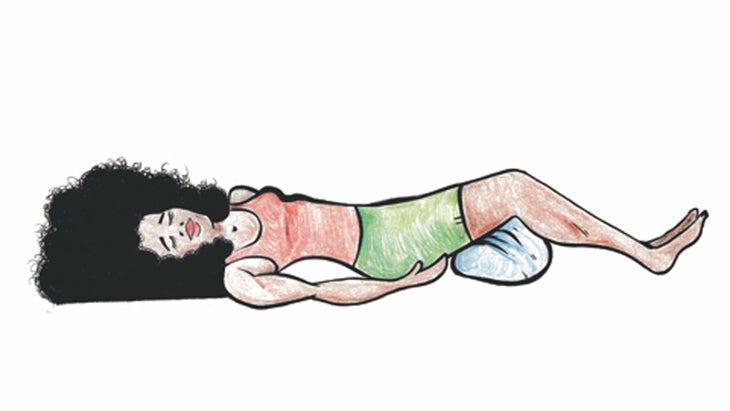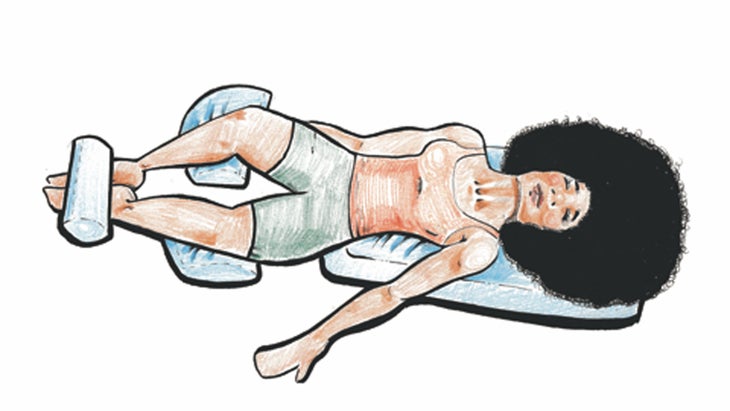Heading out the door? Read this article on the new Outside+ app available now on iOS devices for members! Download the app.
It is my observation that in a racialized world, each of us has emotional wounds based on events of ethnic and race-based stress and trauma that are unacknowledged and therefore unhealed. Even though visible and invisible effects of ethnic and racial stress and trauma abound, many of us remain unaware of its effects because it is so common. The challenge of doing the hard work of healing the ancient pain of racial wounding is long overdue.
It is time for each one of us to take an honest look at the wounding we have endured, and the wounding we have inflicted on others, whether intentional or not. We hurt others as a result of ignorance and of our own inner strife and pain. Now is a time for us to turn within and for healing our own pain as if our very lives depended on it because they do.
See also A Yoga Therapist Shares The Truth About Trauma
I believe Restorative Yoga is a tool that can help us do that. It is time for truth and reconciliation. We don’t need to wait for a commission to be formed, or for systems and other individuals to change in order to do this work. This is an inside job. The work I’m talking about is personal. We can begin the process ourselves.
Outer Shifts Begin With Inner Work
In order to effect social change, we have to approach the task of educating ourselves and of healing our internal wounds with courage, dedication, and devotion.
But the work we have to do goes beyond policy changes, diversity and inclusion initiatives, and laws. The work we have to do requires shifts in consciousness and it starts with individual personal transformation. No law or policy can make that happen. It is time to shine a light on our own ethnic and racial wounds and to begin the process of healing ourselves. This new revolution is going to be internalized, not broadcast or televised. Now is a time for a change of heart, change that occurs from the inside out.
See also A Guide to Navigating True Transformation
Restorative Yoga for Ethnic and Race-Based Stress and Trauma is unique because it invites people of all races, ethnicities, cultures, and nationalities to examine how living in a racialized world affects each of us: from the stress and trauma of the daily lived experiences of racial wounding that people endure, to ‘white fragility’—“a state in which even a minimum amount of racial stress becomes intolerable, triggering a range of defensive reactions” (DiAngelo 2011, p.57).
Why Yoga?
The purpose of yoga is to alleviate pain and suffering and to minimize it in the future. Over time it began to dawn on me that Restorative Yoga had a great deal to offer when it came to easing the emotional pain and suffering brought on by ethnic and race-based stress and trauma. Handling difficult life situations with composure is an important skill to hone. Dealing with race and ethnicity skillfully is critically important in a multiracial, multiethnic, multicultural world. Yoga practices, particularly Restorative Yoga, have much to offer when it comes to dealing with highly charged emotional issues like race and ethnicity. When we practice Restorative Yoga, we are teaching our nervous system how to release contraction and to feel safe coming into deep states of rest that support repair, rejuvenation, and resilience. We are developing a nervous system with a buffer, while strengthening our psychological immune system.
When we learn to experience our emotional pain and discomfort without contracting around it and reacting to it, and instead just let it move through us, our nervous system becomes regulated and we become emotionally regulated. This means our nervous system is in a state of homeostasis, or balance, allowing us to see with more clarity, and we become grounded in a sense of well-being. As this happens, our responses to ethnic and racial offenses become wiser, more functional, and more effective.
A Restorative Practice
This Restorative Yoga sequence is designed to support stillness and comfort to help quiet the nervous system and restore balance between the fight-flight (sympathetic) response and the rest-digest (parasympathetic) response. A focus on breath while silently repeating “I breathe in rest, I breathe out resilience” supports balancing the nervous system and can offer respite and recovery from race related stress and trauma. Bolsters, blankets and blocks are used to increase comfort so poses can be held for extended periods of time, between five and 20 minutes for each pose.
Select one or all four poses depending on how much time you have. Firm pillows, can substitute for bolsters, and cushions or books can substitute for blocks. Finding your edge in a Restorative Yoga practice is based on how much stillness and comfort you can tolerate, not on how much effort you are making.
See also 31 Yoga and Self-Care Resources for Black Yogis (Especially if Social Media Has You Overwhelmed)
Supported Savasana

Living consciously means being aware of what goes on around you, what impact you are having on others, and also what goes on in your inner world, of thoughts, and feelings. Breathe consciously, easily and fully. Receive, reflect, restore.
Sit on the floor with your legs slightly bent. Slide a bolster beneath your knees and slowly lower your back, neck, and then head on to the floor. Let your arms rest comfortably by your sides, preferably palms facing up to broaden and place your shoulder blades more squarely on your back. Close your eyes and become aware of your natural rhythmic breath, and let go of any tension you may feel. Rest here for 5–20 minutes.
See also Why You Need to Get Specific About Savasana to Maximize Its Benefits
Supported Balasana

Our breath is the voice of the body and the quality of breath is what determines the quality of life. Each inhale and exhale tells the story of the natural ebb and flow in all of life. Breathing easily and fully is one of the basic pleasures of being alive. Take the time to pause, breathe and reflect.
Create a support of firm pillows, blankets, or a bolster lengthwise on your mat in front of you. Lower on to your hands and knees, placing them on either side of the support, knees open wide toward the edges of your mat; the tops of your feet are flat on the floor behind you with big toes touching. Sit back on to your heels and, without lifting your hips, fold your torso forward over the length of the bolster or blankets. Place your forearms and the palms of your hands flat on either side of the bolster. Turn your head to one side or the other, resting on your cheek, or rest your forehead on the bolster. Let gravity pull your legs and hips toward the earth as you soften your lower back, and release your tailbone toward your heels. Halfway through, turn your head to the other side as your body continues to settle into the pose. Hold this pose for 5–10 minutes on each side.
See also Escape to Supported Child’s Pose
Supported Salamba Bharadvajasana (Side Twist)

There is a time for doing something and a time for doing nothing. Just because you are doing nothing doesn’t mean nothing is happening. Be still, reflect, restore, rejuvenate and prepare yourself for action.
Place your bolster vertically in the middle of your yoga mat. Sit with your right hip snug up against the narrow end of the bolster. Bend both knees, taking your shins to the left and resting your left ankle in the arch of your right foot. Lift up from your sternum and twist your belly toward the right to square your torso to the front of your mat. Fold over the bolster from this position. Rest your right cheek on the bolster so that your head is facing the same direction as your knees. Keep the back of your neck long and the front of your neck soft. Rest your forearms and hands along the sides of the bolster. Now notice how your breath slows down and deepens. When you are ready, change sides.
See also These 10 Yoga Bolsters are Perfect for a Restorative Home Practice
Supported Supta Baddha Konasana

When you inhale fill your heart with warmth and light. Imagine being immersed in a field of love. Let this loving energy fill your whole being until you feel you are being breathed by it.
Place a bolster vertically in the middle of your yoga mat. Place a folded blanket or a neck pillow at the top of your bolster to support your head or your neck. The lower edge of the blankets or bolster should come directly into contact with your buttocks to support your lower back. Bring the soles of your feet together, touching as if in a prayer position, and spread your knees apart. Each knee fanned out to the side is supported by a yoga block, blanket roll, meditation cushion, or bolsters. Lower yourself on to your back over the bolster. If you like, cover your eyes and body. Breathe deeply and surrender to gravity as you relax. This pose should be held for a minimum of five minutes and can be held for up to 20 minutes.
See also Q&A: How Can I Get Comfortable in Supta Baddha Konasana

© 2020 Singing Dragon. Reprinted with permission. Learn more at singingdragon.com. This article may not be reproduced for any other use without permission. Illustrations by Justine Ross.